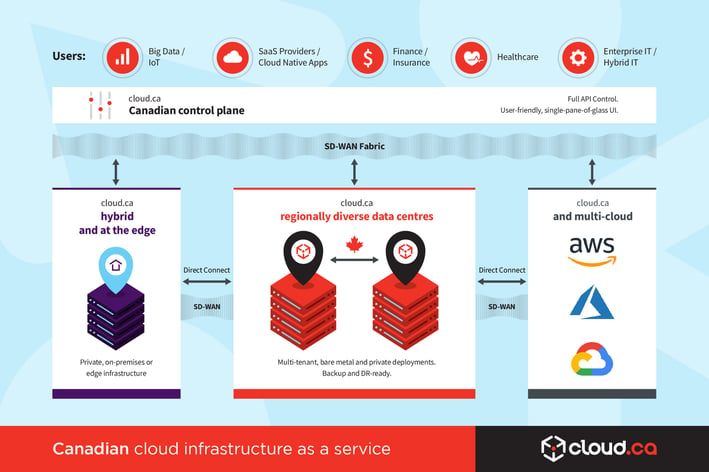It's been over three years since cloud.ca began life as an independent, Canadian-owned and operated Infrastructure-as-a-service (IaaS) provider. As one would expect in the tech industry, much has evolved in that time, particularly cloud-oriented technologies, though no less in the Canadian Cloud Service Provider (CSP) market.
Despite this evolution happening around us, cloud.ca continues to espouse the core values we’ve embraced from the get-go:
- Providing Canadian businesses (or those doing business in Canada) a safe-haven with a Canadian service provider that offers true data sovereignty;
- Acting as a close partner to our customers, and being invested in their success as opposed to simply being a vendor;
- Offering flexible, adaptable solutions that meet customer needs, including the premise that an optimal cloud deployment may involve multiple elements - whether they be CSPs, on-premise elements... Think “hybrid/multi,” and hold onto that thought.
That said, let's take a look at how the Canadian CSP market has changed, and how cloud.ca has kept these core values, and their nuances, relevant.
Upon launch, cloud.ca was one of a select few Canadian IaaS providers offering truly software-defined, API-accessible, self-service, multi-tenant cloud resources. This was often confused, and sometimes still is, with more traditional hosting services which don't provide the real advantages of cloud services. In addition, cloud.ca chose to embrace an open source/cloud-agnostic approach to our software solutions, yielding numerous benefits, including but not limited to, greater flexibility and agility, better economics, standardization, and a lack of vendor lock-in.
Initially, none of the hyperscale cloud providers - AWS, GCP, or Azure - had a Canadian presence, though it didn't take long before this changed. Fast forward to today, where all three have at least a Canadian region. Perception might be that this creates a high degree of competition for regional providers; however, we prefer to view it as an opportunity - one that can allow us to better serve our customer’s evolving requirements.
During this timeframe, we continued to expand cloud.ca’s offerings, adding support for a variety of private/dedicated deployment options that help customers meet needs specific to privacy, compliance and performance. In essence, we can provide software-defined infrastructure solutions ranging from multi-tenant IaaS to private cloud-aaS, including most recently, automated bare metal servers.
While the offerings above all refer to specific data centre deployments (in both Quebec and Ontario), cloud.ca is also available for deployment “at the edge” - allowing for cloud infrastructure to be deployed closer to where it needs to be, often to address issues like latency and/or data privacy. This could be in a customer data centre or colocation environment and can be provided both in the context of a hybrid deployment as well in a fully segregated, stand-alone or “air-gapped” fashion.
These solutions can all be coupled with a variety of dedicated connectivity options that exist for customers to interconnect environments with cloud.ca, including leveraging cloud.ca’s Google Cloud Interconnect (GCI) partnership.
If we take this all collectively, it begins to paint a picture where flexible, hybrid/multi cloud deployments can address a wide variety of customer needs. In the context of those needs, this might take on a number of definitions:
- A customer on-premises infrastructure deployment along with IaaS deployment on multi-tenant, private, or bare metal infrastructure;
- An IaaS deployment (in any variant mentioned above) along with private connectivity to a hyperscale cloud (or other public cloud);
- A customer on-premises deployment of software-defined IaaS (e.g. cloud.ca “at the edge”) along with connectivity to cloud.ca IaaS in our data centre .
Some particular hybrid cloud use cases we have helped address to date include:
- A climate change research organization
- Began by moving almost 100TB of climate change data from the customer premises to cloud.ca,
- Deployed a private cloud-aaS environment in cloud.ca on which customers primary applications will be re-deployed as cloud native applications running on Kubernetes clusters,
- Will leverage cloud.ca GCI for private connectivity allowing the customer to keep primary workloads and data in cloud.ca, while leveraging specialized compute for big data processing in Google Cloud Platform (GCP).
- A leading Canadian real-estate management company
- Consolidating previously in-house IT and hosted, private cloud workloads in a flexible software-defined IaaS with private compute clusters, across multiple regions,
- Leveraging private, dedicated connectivity between their offices and cloud.ca regions, providing low latency, fault tolerant connectivity,
- Virtual workspaces provide end-user compute capabilities in regional office locations,
- Hybrid connectivity into Microsoft Azure for Office 365 applications.
So, where does this leave us? With the notion that, with hybrid, multi-cloud deployments, it IS possible to have a best-of-all-worlds scenario. Leverage the data sovereignty, partner-oriented approach and solution flexibility of a regional CSP like cloud.ca without having to sacrifice the benefits that can be attained through a highly flexible cloud deployment.
Get in touch to find out more...





